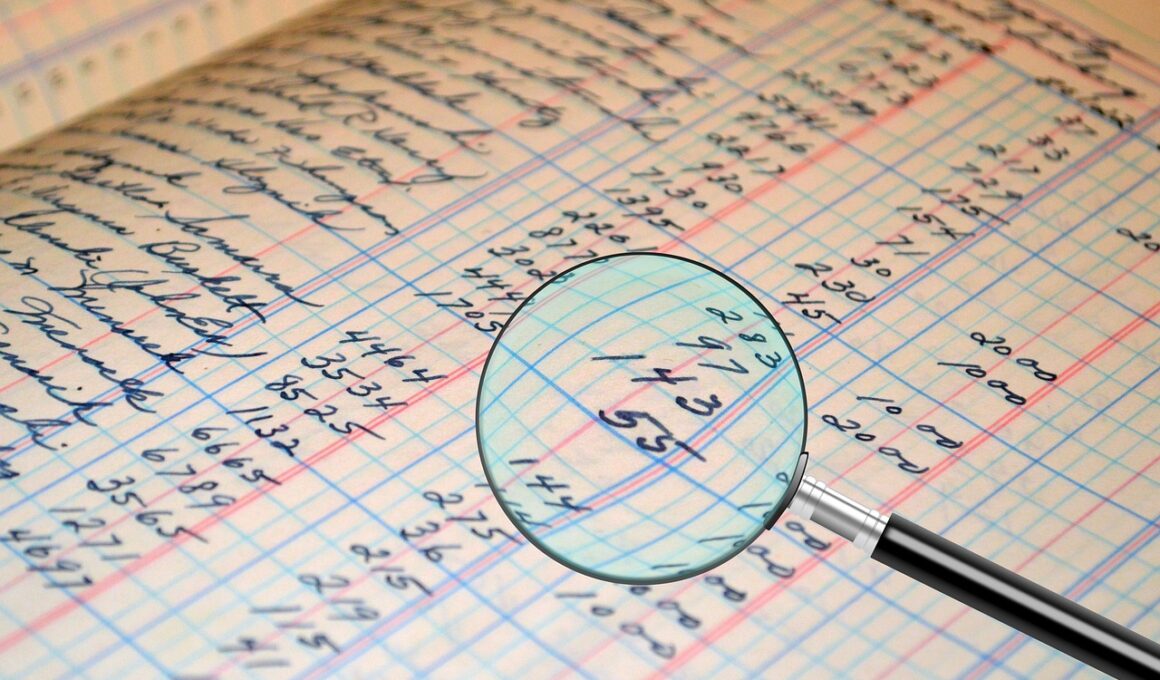Audit Evidence: Collection and Evaluation Methods
Audit evidence forms the backbone of auditing functions, ensuring that auditors gather sufficient information for assessing the integrity of financial statements. The goal is to obtain credible evidence to validate assertions within the financial reports. Generally, there are two primary categories of evidence auditors utilize: internal and external. Internal evidence includes records and documentation generated within the organization, while external evidence includes third-party confirmations, such as letters from banks or suppliers. The quality of audit evidence is pivotal, as it affects the auditor’s opinion on the financial statements. Higher quality evidence leads to enhanced trust in the results of the audit process. Reliable evidence can be obtained through various measures, such as direct observation by the auditor or through verifying transactions. Furthermore, professional standards mandate auditors to possess adequate methodology to assess evidence effectively, which includes understanding its relevance and reliability to the audit objectives. This understanding will aid auditors in making informed decisions, thus reinforcing the entire process of audits in financial integrity.
To collect strong audit evidence, auditors must employ various methods tailored to the specific needs of the audit. These methods include tests of controls, substantive tests, and inquiries. Each method focuses on different aspects of the financial reporting process. For example, tests of controls evaluate the effectiveness of the organization’s internal controls over financial reporting, ensuring there are safeguards against fraud. On the other hand, substantive tests aim to detect material misstatements through detailed procedures, including confirmations and recalculations. Additionally, when conducting inquiries, auditors engage with management and staff to clarify accounting methods, assumptions, and estimates. The conversations can provide insights into areas of potential risk. Documentary evidence is essential as well. Auditors gather documents like payroll records, contracts, and bank statements to verify the numbers presented. However, proper collection doesn’t stop at gathering; it also requires auditors to critically evaluate and analyze the relevance and sincerity of the evidence collected. This systematic approach not only strengthens the audit’s overall credibility but also safeguards against potential inaccuracies in the accounting records.
Evaluating Audit Evidence
After collecting the necessary evidence, auditors engage in the crucial step of evaluating its quality. The evaluation primarily revolves around assessing both relevance and reliability. Relevance refers to how closely the evidence aligns with the specific assertions being tested, while reliability indicates the trustworthiness of the evidence based on its source and nature. For instance, external confirmations are considered more reliable than internal documents or self-generated reports. Auditors apply critical thinking to determine if the evidence collected supports their audit objectives and whether additional evidence is needed to clarify any uncertainties. Furthermore, evidence gathered should corroborate other sources, creating a comprehensive overview of the financial statements audited. This cross-verification process enhances the assurance that auditors can provide to stakeholders. Professionals are encouraged to discuss findings with their teams to challenge interpretations and ensure a thorough understanding of the evidence collected, leading to well-informed decisions in forming audit opinions. This effective evaluation process adds credibility and robustness to the overall audit conclusions drawn.
In assessing audit evidence, auditors consider factors impacting materiality. Materiality refers to the significance of an amount, transaction, or discrepancy that might influence the economic decisions of the users of the financial statements. The significance varies depending on the context and is guided by quantitative and qualitative criteria. For instance, a minor expense may be immaterial in the grand scheme of a large corporation but could be significant for a small business. Thus, the auditor must apply judgment in determining the threshold of materiality during evidence evaluation. This entails analyzing how much misstatement would impact the financial statements and potentially mislead stakeholders. By understanding materiality, auditors can tailor their evidence gathering to focus on areas with higher risks of material misstatements. Additionally, guidelines provided by auditing standards assist auditors in making informed decisions about what levels of evidence are necessary. Experience and expertise also play critical roles in evaluating materiality, so auditors are encouraged to reflect these aspects throughout their investigative processes. This structured approach ensures the financial reporting remains transparent and trustworthy.
Types of Audit Evidence
The types of audit evidence collected can vary extensively to meet the requirements of different audits. Common forms of evidence include physical inspections, analytical procedures, and documented communications. Physical inspections involve auditors directly examining tangible assets, such as inventory or property. This hands-on process enhances belief in the asset valuations presented in financial records. Analytical procedures encompass evaluating financial information through comparisons and calculations. For instance, benchmarking against prior periods or industry standards can reveal significant trends or anomalies that need addressing. Documented undertakings, such as emails, memos, and contracts are relevant documents that can provide essential supporting evidence in understanding agreements or transactions. Furthermore, observations of company processes also stand as significant forms of evidence, since witnessing controls in action can lend validation to the entire audit. Engaging in multiple forms of evidence creates a layered understanding, strengthening the credibility of the audit findings. The combination of varied evidence types enables auditors to form sound conclusions about the financial state of the organization.
One of the challenges auditors encounter during evidence collection is ensuring the documentation’s sufficiency. Sufficiency pertains to the quantity and depth of evidence that supports the auditor’s findings conclusively. Determining sufficiency involves professional judgment, weighing the balance between what is adequate in theory versus what has been observed in practice. Often, auditors will find themselves in a situation where evidence might appear adequate on the surface, yet deeper analysis reveals substantial gaps. Auditors must maintain a keen eye for subtle details that could point to inadequate evidence. It is recommended to approach sufficiency through iterative rounds of evidence gathering, where auditors continuously reassess their findings and add complementary evidence as needed. Additionally, auditors must stay abreast of current standards and practices to keep their methodologies aligned with regulatory expectations. In doing so, they safeguard the integrity of their audit opinion against challenges and criticism from stakeholders. A rigorous, stringent approach to sufficiency solidifies the groundwork for a dependable audit process.
Conclusion on Audit Evidence
In conclusion, audit evidence is vital to realizing an objective, transparent, and effective audit process. Collecting high-quality evidence using diverse and relevant methods lays the foundation for meaningful evaluation. While conducting audits, teams must remain versatile and employ multiple modalities to gather evidence, ensuring they cover all critical areas. Evaluating this evidence with respect to relevance, reliability, and materiality enhances the overall credibility of the audit. Additionally, understanding different types of evidence and their respective qualities allows auditors to warrant various methodologies that align with their audit strategy. Overcomes challenges surrounding sufficiency ensures the evidence collected leads to unambiguous conclusions that reflect the company’s financial state accurately. Ultimately, thorough consideration of these factors and methodologies leads to strong audit opinions that stakeholders can trust. Auditors have a responsibility to uphold the ethical standards tied to their profession, and robust evidence collection and evaluation is paramount to meeting these obligations. Continuous learning and adaptation to evolving practices will further bolster auditors’ abilities, enabling them to navigate complexities effectively in their roles.
Effective communication is crucial, as conveying the right insights derived from audit evidence enhances overall understanding. Regular interactions between auditors and management are essential in obtaining clarity on financial records and operational processes. By collaborating, both parties can pinpoint concerns and seek resolutions grounded in factual evidence. This synergy encourages a culture of transparency and accountability at all levels of the organization. Furthermore, establishing an environment ripe for sharing findings ensures all stakeholders can benefit from audit reports and ensuing recommendations. Proper dissemination happens through detailed reports, presentations to management, and discussions about practical implications of the audit results. Ultimately, when audit conclusions are disseminated effectively, they foster trust among stakeholders and facilitate informed decision-making based on comprehensive insights derived from the audit evidence. Adequate communication strategies promote an understanding of risks involved and enhance cooperation in mitigating those risks. Whether through formal reports or informal discussions, what matters is the outcome—the strengthened trust in the integrity of financial reporting and decision-making related to those findings.


